Mixing Modern and Antique Furniture: Style Tips & Ideas
05.14.25
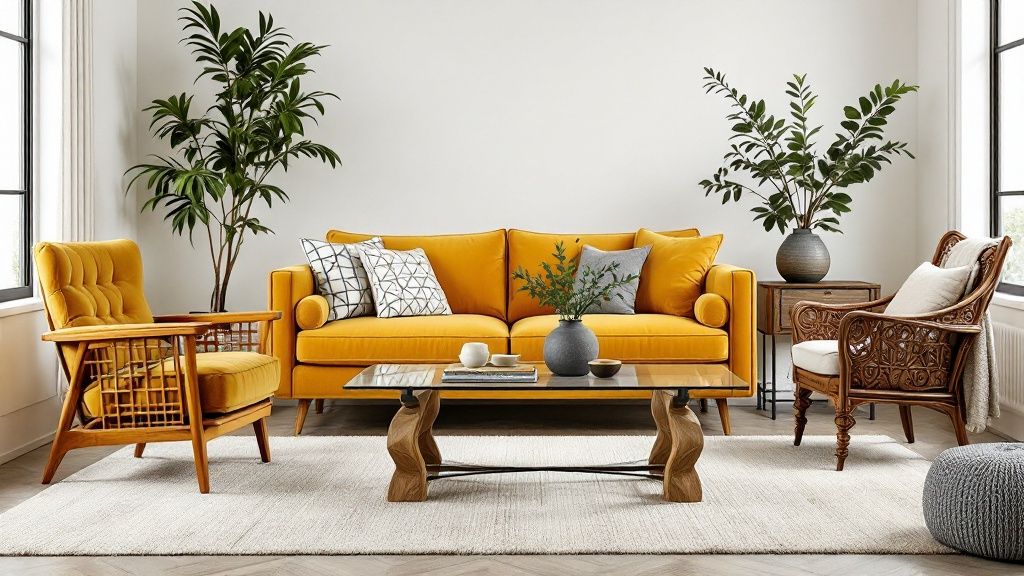
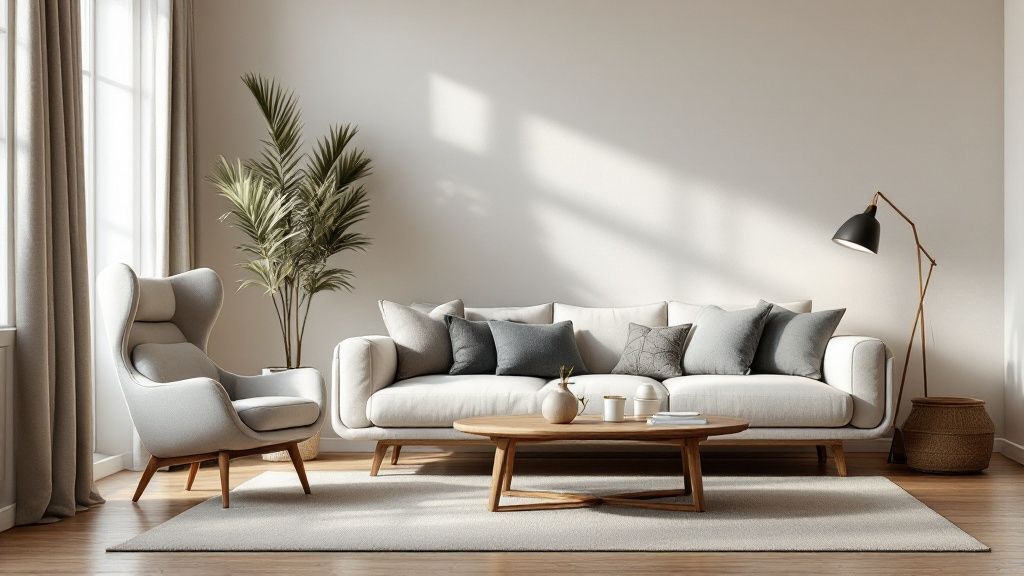
More and more, homeowners are stepping away from the uniformity of matching furniture sets. They’re embracing personalized spaces that tell their unique stories. This movement towards eclecticism allows for a curated blend of styles, creating a home filled with character, not a showroom replica. Understanding how to mix furniture styles effectively is the key to achieving a cohesive and visually appealing design.
One fundamental principle of successful style mixing is intentionality. Instead of randomly accumulating furniture, a curated approach focuses on harmony between different pieces. Perhaps a vintage armchair paired with a modern sofa, connected intentionally through a shared color palette or complementary textures. This thoughtful approach separates a curated space from one that feels cluttered.
The growing availability of diverse furniture styles fuels this trend. The global furniture market, valued at USD 568.60 billion in 2024, is projected to reach USD 878.14 billion by 2032. This growth is driven by trends like home renovation, with consumers searching for unique, stylish pieces. This expanded access makes mixing and matching easier than ever. Find more detailed statistics here: Fortune Business Insights
Mixing furniture styles effectively involves a conversation between pieces. Achieve this through texture repetition, where similar fabrics or finishes create a visual link. Echoing design elements, like curves or geometric shapes, builds connections between seemingly different items. A mid-century modern coffee table with rounded edges could complement a similarly shaped contemporary sofa, for example.
By focusing on these principles, you can transform your home into a reflection of your personal style. Create a space that is both beautiful and meaningful. This curated approach to mixing furniture styles is more than a passing trend; it’s about creating a home that truly speaks to your personality and taste.
The secret to a successful mix of furniture styles isn’t random chance. It’s a deliberate process, a cohesive narrative woven throughout your space. Professional designers achieve this by using unifying elements to bridge the gap between seemingly different furniture pieces. These elements create harmony, making diverse styles feel as though they belong together.
A consistent color story is one of the most effective unifying elements. Repeating a few key colors in your furniture and decor creates visual continuity. For example, echoing shades of blue and green in throw pillows, artwork, and an area rug can tie together a traditional wooden armchair and a modern metal side table. Recurring materials also play a vital role. The warmth of wood, repeated in picture frames, flooring, or decorative bowls, links furniture from different eras.
This infographic visualizes key differences between minimalist and traditional furniture across color palette, primary materials, and ornamentation:
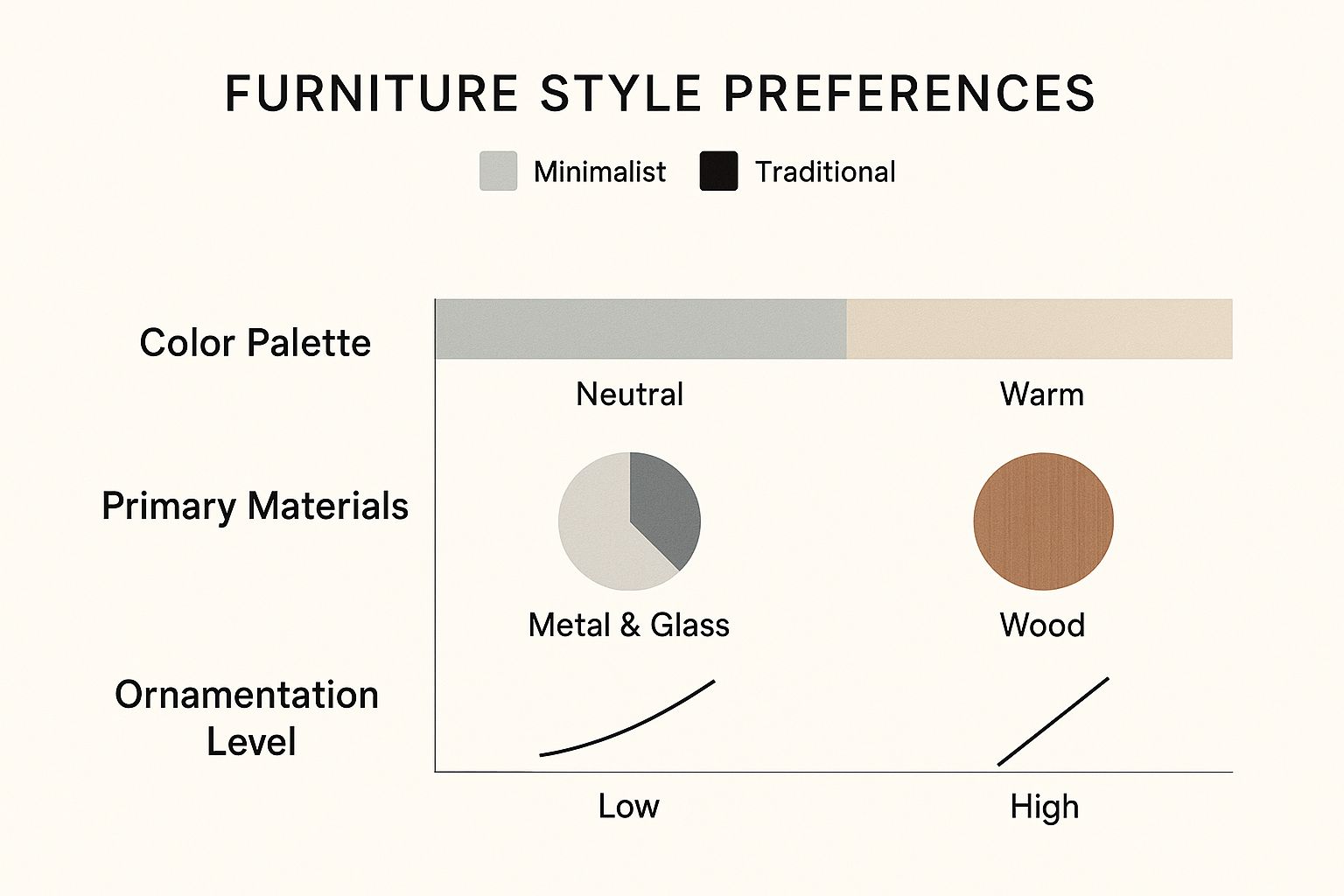
As the infographic shows, even contrasting styles can share common ground. Using a neutral color palette, even with different materials, creates visual balance. This highlights the importance of strategic choices when mixing styles. For more design tips, check out How to master the principles of interior design.
To help illustrate further, let’s take a look at some specific unifying elements:
Master Unifying Elements for Mixed Furniture Styles: A breakdown of elements that can tie different furniture styles together effectively
| Unifying Element | How It Works | Example Pairings |
|---|---|---|
| Consistent Color Story | Repeating key colors throughout furniture and decor | Blue and green accents connecting a traditional armchair and modern side table |
| Recurring Materials | Using the same material in multiple pieces | Wood in picture frames, flooring, and bowls tying together various furniture pieces |
| Complementary Shapes | Matching the silhouette of furniture pieces | Rounded armchair echoing a circular coffee table |
| Texture Repetition | Using similar textures across different materials | Leather sofa, woven rug, and textured wood coffee table |
| Finishes | Matching finishes creates visual cohesion | Polished wood or matte metal finishes repeated on different furniture pieces |
This table highlights the power of these unifying elements to create a cohesive look, regardless of the individual styles of furniture. By thoughtfully incorporating these elements, you can create a space that feels curated and intentional.
Beyond color and materials, complementary shapes and intentional proportions are essential for a unified look. Think of it as a conversation between your furniture pieces. A rounded armchair can complement the curves of a circular coffee table, creating visual dialogue despite differences in style or upholstery. Paying attention to the overall silhouette of your furniture is as crucial as its specific style.
Texture repetition further enhances this conversation. Imagine a leather sofa with a woven rug and a textured wood coffee table. Though the materials are different, the repeated texture connects them visually. Similarly, consistent finishes, such as polished wood or matte metal, bridge seemingly different styles. Attention to these details is key to a truly curated space.
Finally, powerful anchor pieces are key to bringing an eclectic vision to life. These statement pieces bridge style divides. A large, intricately carved wooden chest, for instance, can be a focal point that connects more understated pieces from various eras. This creates harmony without sacrificing your unique vision. This intentional approach allows you to embrace diverse styles while creating a cohesive and visually appealing space.
Mixing furniture styles from different eras is a powerful way to create a space with depth and character. It’s more than just placing pieces together; it’s about fostering a conversation between time periods. Consider how a Victorian settee might interact with a mid-century modern side table, or how an Art Deco mirror reflects the lines of a contemporary sofa.
Some historical styles naturally complement each other. The ornate details of Victorian furniture, for example, can surprisingly pair well with the clean lines of mid-century modern pieces. The shared emphasis on craftsmanship, though expressed differently, creates an intriguing juxtaposition. Similarly, the industrial aesthetic, with its raw materials and utilitarian forms, blends seamlessly with rustic elements, creating a grounded and contemporary feel.
Other combinations, however, require more careful consideration. When mixing furniture styles, think about how different eras used different construction techniques. Understanding cabinet construction methods can enhance your appreciation for the craftsmanship and design choices of various periods.
The most captivating mixed-style interiors often incorporate deliberate tension. This isn’t about creating chaos, but rather using contrasting elements to highlight each piece’s unique qualities. Juxtaposing traditional and modern, minimalist and ornate, or industrial and rustic creates visual intrigue. This interplay adds layers of meaning, telling a richer story than a uniformly decorated room.
Playing with contrasts in scale and proportion further enhances this dynamic. A delicate antique chair next to a robust modern sofa creates a visual conversation about form and function.
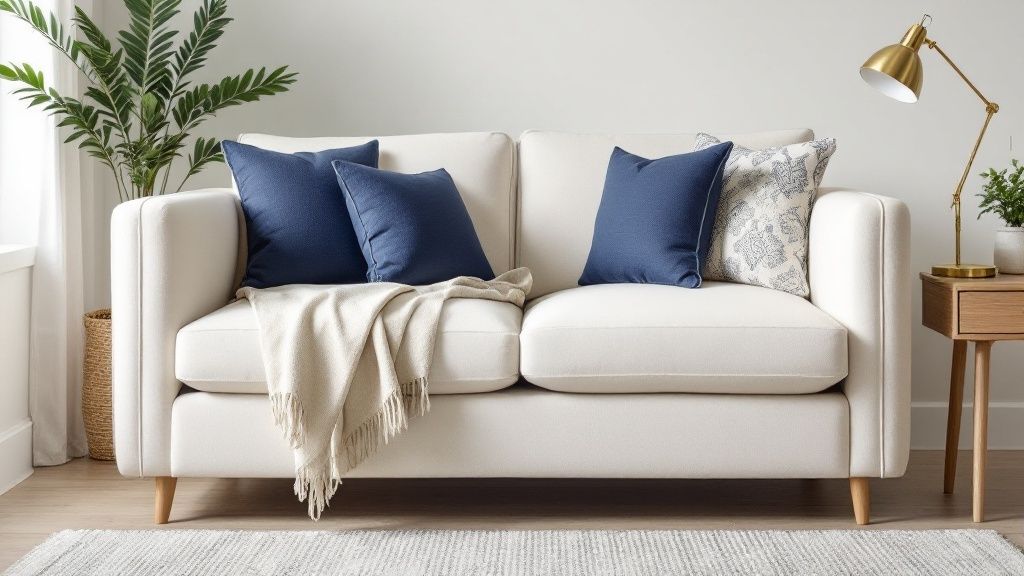
When combining dramatically different styles, managing scale and proportion is crucial. A grand Victorian settee paired with a diminutive mid-century side table might feel accidental. But by considering each piece’s visual weight, you can create a balanced arrangement. This might involve choosing a larger side table or grouping smaller pieces to counterpoint the settee.
Furthermore, understanding market segmentation offers insights. In 2024, the wood segment dominated the furniture market with revenue of USD 460.3 billion, and offline channels comprised 83% of the market share. This highlights the significance of traditional materials and physical stores for consumers mixing furniture styles. Discover more at GMI Insights.
Before committing to a pairing, a practical framework is helpful. Create mood boards, sketch layouts, or use online design tools to visualize arrangements. By experimenting and considering the interplay of styles, scales, and proportions, you’ll develop confidence in creating harmonious cross-era combinations. This thoughtful approach ensures your interior reflects your unique personality and design vision.
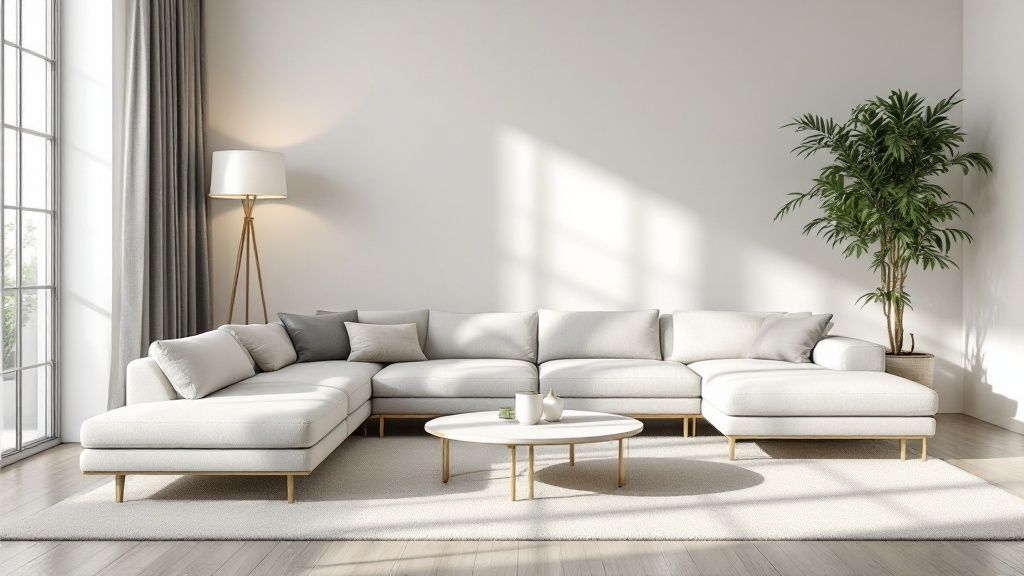
Creating a visually appealing room by mixing furniture styles isn’t about giving each style equal airtime. It’s more about finding a balance, a harmony between dominant and accent pieces. And that’s where the 80/20 rule comes in, a tried-and-true technique beloved by interior designers.
This design principle centers around designating a dominant style for about 80% of your furniture. This establishes a strong foundation and gives the room a clear stylistic direction. The remaining 20% is reserved for accent pieces that bring in contrast and personality. This is the key to adding visual flair without making the space feel cluttered or chaotic.
Think of your room as a blank canvas. The 80/20 rule helps you compose a cohesive image by strategically placing furniture styles. Your dominant style forms the backdrop, the main narrative of the room. Accent pieces play supporting roles, highlighting specific areas or showcasing unique design elements. For instance, if your dominant style is mid-century modern, you could incorporate a vintage Persian rug or an Art Deco mirror as accent pieces.
Visual weight is another essential factor. Larger pieces naturally command more attention, so they generally fall within the 80% dominant style category. Smaller accessories and accent furniture are perfect for introducing the contrasting 20%. This equilibrium prevents any single piece, or style, from overwhelming the design.
Accent pieces, though fewer in number, hold significant power in drawing the eye and shaping the overall aesthetic. They create focal points that guide the viewer’s gaze through the room. Imagine a vibrant armchair against a neutral wall or a striking sculpture on a simple side table. These details introduce depth and a sense of curated eclecticism.
For deeper insights into furniture styles, you might find this helpful: How to master furniture styles.
The table below illustrates how the 80/20 rule, with its emphasis on dominant and accent styles, can be applied to different rooms in your home. It provides specific examples and explains the rationale behind each pairing.
| Room Type | Dominant Style (80%) | Accent Style (20%) | Why This Works |
|---|---|---|---|
| Living Room | Modern Farmhouse | Industrial | The warmth of farmhouse style is balanced by the raw, edgy elements of industrial design. |
| Bedroom | Minimalist | Bohemian | The clean lines of minimalism are softened with textured textiles and global-inspired accents of bohemian style. |
| Dining Room | Traditional | Contemporary | Classic traditional furniture is updated with contemporary lighting and artwork. |
| Home Office | Scandinavian | Mid-Century Modern | The airy feel of Scandinavian design is complemented by the sleek lines and functionality of mid-century modern pieces. |
This table demonstrates the versatility of the 80/20 rule. By thoughtfully selecting dominant and accent styles, you can create a harmonious and personalized space in any room.
Achieving the right balance is essential. Too many accent pieces can shift the atmosphere from curated to cluttered. This is where developing a discerning eye becomes invaluable. Step back and evaluate your room regularly. Does it feel balanced and inviting? Or are too many elements competing for attention? Trust your intuition and be willing to edit. Sometimes, less truly is more.
Blending furniture styles can be a challenge. Incorporating multifunctional pieces can help tie disparate looks together, creating a harmonious and practical living space. These versatile items act as a bridge, connecting different design languages while maximizing functionality. Learn more about this approach to design at Multifunctional Spaces. This is especially important in smaller homes, where each piece must serve multiple purposes.
Multifunctional furniture thrives in mixed-style interiors because of its inherent adaptability. A convertible sofa, for example, can easily shift from a sleek, modern seating arrangement to a comfortable, traditional-style bed. This flexibility allows it to complement diverse styles within the same room.
Similarly, an expandable dining table can bridge the gap between a rustic farmhouse aesthetic and a more contemporary setting. Its ability to adapt to different sizes and functions makes it essential in a mixed-style dining area. A storage ottoman, for another example, can be both a practical storage solution and a stylish footrest. Depending on the upholstery and material, it can blend with various furniture styles. This creates fluidity between design elements, resulting in a unified space.
The increasing popularity of multifunctional furniture isn’t a fad. The global multifunctional furniture market was valued at USD 7.21 billion in 2023. It’s projected to grow at a CAGR of 6.6% from 2024 to 2030. This growth is driven by innovative designs that prioritize both functionality and aesthetics, meeting the needs of compact living spaces and evolving work-from-home setups. The Asia Pacific region is expected to see significant growth, spurred by rapid urbanization and a rising middle class looking for versatile furniture solutions. You can find more information on this growing market at Multifunctional Furniture Market Research.
Multifunctional pieces don’t just blend in; they can also serve as anchors in an eclectically designed room. A stylish, multifunctional bookshelf, for instance, can display books, artwork, and decorative objects. This creates a visual focal point that ties together surrounding furniture from different eras and styles.
This approach allows you to embrace a variety of styles while maintaining a cohesive and curated look. These pieces also provide practical solutions for modern living, especially in smaller spaces where every item needs to be both beautiful and useful.
Designers frequently discuss how multifunctional pieces can enhance a mixed-style interior. They emphasize selecting items that not only serve multiple purposes but also contribute to the overall aesthetic. A well-chosen piece, like a console table that doubles as a desk, can be both practical and stylish, blending seamlessly with other furniture.
By carefully considering the form and function of each item, you can maximize your space’s potential. This helps create a cohesive and personalized design reflecting your unique style. This approach ensures your mixed-style interior is visually appealing and functional.
Mixing furniture styles can transform a house into a truly personalized home. However, there’s a fine line between a curated, eclectic look and a chaotic mismatch. This section explores common design pitfalls to avoid when mixing furniture styles, offering practical solutions for a harmonious interior. For more inspiration, check out this resource: How to Master Furniture Styles.
A frequent mistake is overcrowding a room with too many statement pieces. Each piece vies for attention, resulting in a visually overwhelming space. Imagine a room with a bold, patterned rug, an ornate antique armoire, and a sculptural sofa. Stunning individually, these pieces clash when combined, creating visual chaos.
The Solution: Select one or two key statement pieces and design the room around them. If your rug is the star, choose more neutral furniture to let it shine.
Mixing furniture of drastically different scales and proportions presents another challenge. A delicate antique chair can appear lost beside a large sectional, creating an imbalance. This disrupts visual flow, making the room feel disjointed.
The Solution: Balance varying scales by grouping furniture strategically. Smaller pieces together can offset larger items. A large rug can anchor the space, visually connecting disparate pieces.
A successful mixed-style interior relies on unifying elements: repeating colors, materials, textures, or shapes. These threads create a cohesive narrative. Without them, the room feels like a random assortment rather than a curated collection.
The Solution: Choose a unifying element and weave it throughout the room. A specific wood tone in furniture legs and frames, or a color palette carried through textiles and accessories, creates a sense of harmony.
While eclecticism embraces diversity, over-decorating can quickly lead to clutter. Too many accessories detract from the furniture, making the space feel busy and uninviting.
The Solution: Embrace minimalism. Edit accessories thoughtfully, ensuring each piece contributes to the overall design. Prioritize quality over quantity, choosing a few impactful pieces rather than a collection of clutter.
Here are practical tips for successfully mixing furniture styles:
By understanding these common pitfalls and implementing these solutions, you can confidently mix furniture styles to create a unique and visually appealing space reflecting your personality.
Ready to furnish your dream home? Explore our curated collection of high-quality pre-owned furniture at High End Used Furniture and discover how we can help you create a stylish home.
High end used furniture